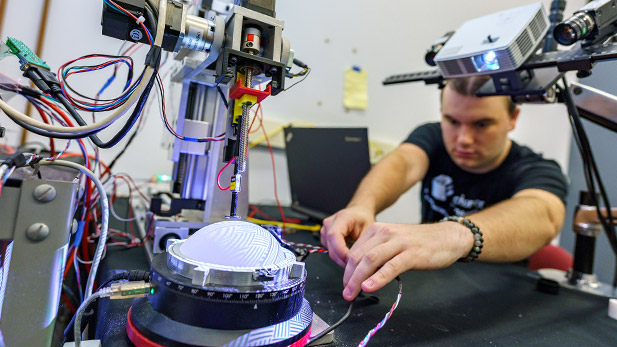Faculty, Students’ Robotics and Research Make Significant Contributions to Breast Cancer Detection Techniques

Mechanical engineering senior Andrew Hubbard used a student-developed device to collect data by lightly indenting multiple locations within breast phantoms to detect unusually stiff regions that could be suspected tumors.
Recent advancements made by Rose-Hulman students have provided a significant step forward in automating and refining the manual breast exam process, which has enhanced the research being done by two professors using inverse problem-solving techniques to help early detection of breast cancer.
The specially designed electromechanical device (robot) lightly indents silicone simulated breast tissue test samples (phantoms) at multiple locations in search of unusually stiff regions. Results are reflected in a 3D map, which can reveal suspected tumors that require medical follow-up.
This new procedure has correctly identified 14 tumor-free phantoms and 14 tumor-containing phantoms in early testing. It’s a significant achievement that could help pave the way for a more comfortable exam than current mammogram procedures.
“This is a major step forward in undergraduate-level research that’s been taking incremental steps forward on our campus throughout the years. We’re closer to getting the technology that provides valuable data to further enhance our studies,” said mechanical engineering professor Lori Olson, PhD, who has joined with electrical and computer engineering professor Robert Throne, PhD, in studies that have been underway for nearly 20 years.
“Real engineering is a step-by-step process that’s somewhat methodical and tedious but nonetheless noteworthy,” said Olson, who earned the Rose-Hulman Board of Trustees Outstanding Scholar Award in 2013. (Throne received the award in 2021.) “This has been a great learning experience for the students who are interested in a possible career in research.”
That would include Andrew Hubbard, a senior mechanical engineering major with a robotics minor, who redesigned the robotic arm’s mechanism and control system, and collected valuable data for future studies and research papers as part of Rose-Hulman’s Summer Undergraduate Research Fellowships (R-SURF) program.
“This was a great opportunity to work with Dr. Olson on an interesting project that happens to be a material application for my career interests in robotics. It also dipped my toes into research and things associated with graduate school,” said Hubbard, who is examining several postgraduate opportunities.
Past students have used the undergraduate research experience to open the doors to master’s and doctoral degrees and be listed with Olson and Throne as co-authors on nationally published scholarly papers and presentations at national conferences.
Early detection of breast cancer is considered crucial to patient survival. Mammograms and manual breast exams are the most widely used and effective methods for early detection, but those methods have physical and psychological drawbacks. Also since mammograms are breast x-rays and expose the patient to radiation, there are limitations to specific age and risk groups. Mammograms also are sensitive to tissue density – not stiffness.
According to Olson, cancerous tissues within most patients are more dense than healthy tissues, but for the half of women over 40 with dense breasts, the differences are small and detection can be difficult. Cancerous tissues have an elastic stiffness that may be as much as 10 times stiffer than healthy tissues.
Meanwhile, manual breast exams do rely on stiffness, but they are limited in their ability to reliably detect tumors. They only produce information about the site where the force is applied. They also do not provide any quantitative or recordable information for comparison with future exams.
Olson and Throne are striving to automate and enhance the manual breast exam process with the device that has been refined by students conducting senior-year mechanical engineering capstone projects, independent research projects and specialized summer internships. These projects have been supported by the National Science Foundation, Rose-Hulman’s Lawrence J. Giacoletto endowment fund (from 2018-21 when Throne was the Giacoletto Endowed Chair of Electrical and Computer Engineering), and the RSURF program.
Assistant Professor of Mechanical Engineering Dan Stoecklein, PhD, and students have enhanced aspects of the project by applying machine learning principles to data similar to that collected by the robotic arm.
“Our students have made huge contributions to this project. It’s been beneficial for them, enhancing their college experiences, and the project,” Olson said. “Now, since we have determined that our process works with medium-sized breast models, we need to examine if stiff areas can be readily detected in large and small breasts, and if any changes to our system have to be made.”
Former student researchers assisting with the project were Allison Crump, Matthew Billingsley, Matthew Conrad, Emily Cottingham, Caitlin Douglas, Robert Fleishel, Jonathan Gannon, Kaelyn Griffin, Tianhong Han, Matthew Hummel, Wanli He, Nicolae Iovanac, Thomas Janssen, Michael Jones, Zhicheng Kai, Tressa Lauer, Bowen Li, Xiaoyin Ling, Allen Liu, Emily Macak, Haley O’Neil, Gustavo Romo, Emily Rusnak, Geoffrey Tan, Ryan Tarr, Michael Samp, Brendan Smyth, Justin Speedy, Griffin Steffy, James Tumavich, and Jiaojiao Wang. Contributors on capstone design teams were Allison Bromenschenkel, Logan Caldwell, Peter Garnache, Taylor Graham, Erin Minervi, Carson Stone, and Dayong (Ray) Tong.